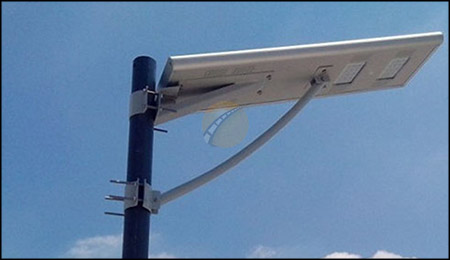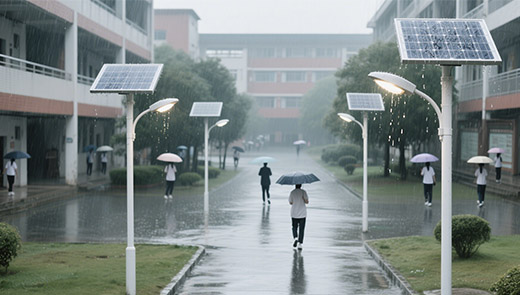How to Choose the Best Solar Light Batteries
In today's world where clean energy is becoming increasingly widespread, solar street lights have gained popularity for urban and rural road lighting due to their energy-saving and environmentally friendly characteristics. Within solar street light systems, solar batteries serve as the core component for energy storage, and their performance directly impacts the lighting duration, stability, and lifespan of the street lights. So, how should one select the best solar street light batteries?

What Are Solar Batteries?
Solar batteries, also known as solar energy storage systems or solar power banks, are devices that store the electrical energy generated by solar panels. During daylight hours when sunlight is abundant, solar batteries quietly “absorb” the electrical energy converted by solar panels and store it. At night when the sun sets, or during consecutive days of cloudy weather with insufficient sunlight, they release the stored energy to provide power for solar street lights.
Moreover, solar batteries can serve as backup power sources during power outages, significantly enhancing the reliability of solar systems and reducing dependence on traditional grids. In remote areas with unstable power supply, solar batteries ensure the continuous and stable operation of streetlights, providing convenience for residents' nighttime travel. Furthermore, as environmental awareness grows, solar batteries, with their clean and pollution-free characteristics, effectively reduce carbon emissions, contributing to the achievement of carbon neutrality goals, and enabling green energy to play a greater role in lighting applications in both urban and rural areas.
Types of Solar Batteries
Lead-Acid Battery
The nominal unit voltage of a lead-acid battery is 2.2V, with a total voltage of 12V, capable of reliable charging for approximately 350 cycles. During charging, it does not generate excessive heat, with an optimal charging temperature range of 20–50°C. This stable charging characteristic allows it to operate safely in ordinary environments with less stringent temperature requirements. However, this battery is a more traditional type, characterized by its large size and heavy weight. Its bulky nature not only increases installation and transportation difficulties but also limits its application in scenarios with limited space. Except for some split-type solar street lights, it is not suitable for most modern solar street light products, as modern solar street lights prioritize lightweight, high efficiency, and aesthetic appeal, which lead-acid batteries struggle to meet.
Gel Battery
Gel batteries have a nominal unit voltage of 2.35–2.4V, with total voltages available in 12V or 24V specifications. They can withstand up to 500 charge cycles and have relatively low costs, making them attractive for cost-sensitive projects. Their ideal charging temperature range is 15–40°C, which is more stringent than other battery types. However, it has significant drawbacks: overcharging can easily cause damage, so a suitable charging regulator must be installed, which inevitably increases system complexity and cost. Additionally, gel batteries perform poorly in high-temperature environments. High temperatures cause the gel inside the battery to contract and harden, thereby affecting battery performance, and in severe cases may even render the battery unusable, severely limiting its application in high-temperature regions.
Ternary Lithium (Li-ion)
Ternary lithium batteries have a nominal cell voltage of 3.7V, a total voltage of 11.1 (12)V, and can be charged 500–800 times. They have a very low self-discharge rate. This means that during long-term storage, the battery loses very little charge and can maintain a sufficient charge reserve for an extended period. This battery comes in a variety of shapes and sizes, offering flexible adaptability to meet the needs of solar street lights with different designs and spatial requirements. However, this also makes it difficult for different devices to be interchangeable, requiring strict matching of specifications during replacement or maintenance, thereby increasing the complexity of accessory management and maintenance.
Its greatest advantage lies in its high energy capacity; under the same volume, ternary lithium batteries can store more energy, providing longer-lasting illumination for street lights. Additionally, it can withstand higher operating temperatures, ensuring stable performance even in hot summer conditions without significant performance degradation due to high temperatures. Compared to other battery types on the market, ternary lithium batteries significantly enhance the reliability of solar systems, reducing lighting interruptions caused by battery issues; lower maintenance costs by minimizing frequent replacements and repairs; and improve energy efficiency by converting solar energy into usable electricity more effectively, making them ideal for modern high-performance solar streetlights.

Lithium Lron Phosphate Battery (LiFePO4)
The nominal cell voltage of the lithium iron phosphate battery is 3.2V, with a total voltage of 12.8V or 25.6V. Compared to many other batteries, it has an extremely long service life, with minimal power loss even when left unused for extended periods. This battery is capable of operating in high-temperature environments, with a maximum temperature tolerance of 60°C, ensuring stable performance in hot summer conditions or high-temperature industrial areas. Additionally, it requires minimal maintenance, with a charge/discharge cycle life of up to 2,000 cycles, far exceeding that of ordinary batteries. Its internal structure uses stable lithium iron phosphate material, minimizing the risk of thermal runaway and ensuring high safety. With its efficiency, safety, and durability, the lithium iron phosphate battery is increasingly being adopted in new solar streetlight products, making it the top choice for those seeking high-quality, long-lasting lighting solutions.
Tips for Choosing Solar Battery Types
Application/Battery Size
The first step in selecting a solar battery is to accurately determine its application scenario. Consider whether the battery will be used in an off-grid solar system that operates independently of the grid, a grid-connected solar system that supplements the main grid, or as an emergency backup power source. Additionally, thoroughly understanding the anticipated power requirements is crucial, as this directly determines the required battery size and capacity.
For example, solar street lights used for large-scale plaza lighting have high power requirements and thus require high-capacity batteries of appropriate size; whereas solar street lights used for courtyard lighting have relatively lower power requirements, so batteries of suitable power and size can be selected. After determining the application scenario and power requirements, match the appropriate battery size to ensure the selected battery meets both power needs and seamlessly integrates into the installation environment.
Cost
When selecting solar batteries, one should not solely focus on the initial purchase cost but conduct a comprehensive cost analysis. Total costs encompass multiple factors such as the battery's expected lifespan, efficiency, and maintenance requirements. Some batteries may have a lower purchase price, but due to their short lifespan, frequent maintenance, and high maintenance costs, the total cost over the long term may exceed that of batteries with a higher initial price. Conversely, batteries with higher initial costs but longer lifespans, higher efficiency, and lower maintenance requirements are often more cost-effective in the long run and represent a more economical choice.

Battery Capacity
Battery capacity is one of the core factors in selecting solar batteries, referring to the amount of energy the battery can store, typically measured in kilowatt-hours (kWh). Whether for business or personal use, battery capacity should be closely aligned with energy requirements. Before making a decision, it is recommended to thoroughly document the power consumption of appliances and overall energy usage, using this as a basis to select a battery with sufficient capacity to meet actual needs. If the battery capacity is too small, it may fail to meet lighting requirements; if it is too large, it may result in resource waste and increased costs.
Battery Lifetime
Battery lifespan is equally important, typically measured by the number of charge-discharge cycles the battery can undergo before its performance significantly declines. Different types of batteries have significantly different lifespans. For example, the cycle count for ordinary lead-acid batteries ranges from 200 to 1,000 cycles, while lithium-ion batteries (such as ternary lithium batteries and lithium iron phosphate batteries) can reach thousands of cycles. Choosing batteries with a longer lifespan not only reduces the frequency of battery replacements and lowers maintenance costs but also provides a more cost-effective and sustainable solution for solar energy storage.
Efficiency
Battery efficiency directly affects how much of the energy generated by solar panels can be effectively stored. It is expressed as a percentage, representing the ratio of stored energy to input energy. For example, if 100 watt-hours of energy are input but only 80 watt-hours can be stored, the battery efficiency is 80%. Clearly, higher battery efficiency means more solar energy can be stored, thereby providing more ample power for streetlights. Therefore, when selecting solar batteries, it is advisable to prioritize products with higher efficiency.
Power Rating
The power rating refers to the maximum power that a battery can provide within a given time frame, typically measured in watts (W) or kilowatts (kW). It determines the amount of energy the battery can supply to a load or system. When selecting a battery's power rating, it is essential to strictly adhere to the specific requirements of the solar power system. If the system needs to power multiple large loads simultaneously, a battery with a higher power rating must be chosen to ensure adequate and stable energy supply. Additionally, both the maximum and continuous power ratings must be considered. The former refers to the maximum power a battery can provide in a short period (seconds or minutes), while the latter refers to the power it can sustain over an extended period. Only by balancing both can the stable operation of the solar streetlight system be ensured.

Tips for Extending the Lifespan of Solar Light Batteries
Regularly Clean the Solar Panels
As usage time increases, solar panels tend to accumulate dust, dirt, and debris on their surfaces, which reduces their efficiency in absorbing sunlight and, consequently, affects battery charging performance. Therefore, solar panels should be regularly wiped clean to maintain their surface cleanliness, ensuring they can efficiently absorb sunlight and fully charge the battery.
Prevent Pvercharging of Batteries
Although most solar street lights are equipped with built-in charging controllers to prevent overcharging, reliance on the controller alone is insufficient. During daily use, it is still necessary to monitor the battery charging process to prevent overcharging caused by controller malfunctions or abnormal wiring. Overcharging can damage the battery, reduce its capacity, and significantly shorten its lifespan.
Properly Store the Battery
During winter or when the solar street light is not in use for an extended period, the battery should be removed promptly. Store the battery in a cool, dry environment, avoiding exposure to extreme temperatures (too high or too low) and humid conditions. Improper storage conditions can cause irreversible damage to the battery, significantly reducing its lifespan.
By thoroughly understanding the types of solar batteries, mastering the key points for selection, and performing regular maintenance, you can choose reliable, efficient, and long-lasting batteries for solar street lights, fully leveraging their eco-friendly and cost-effective advantages to bring more convenience and light to your life.




